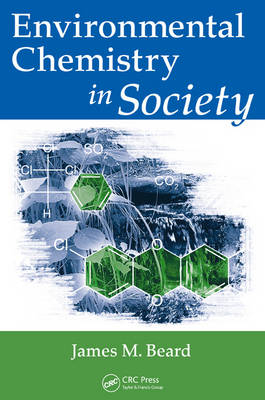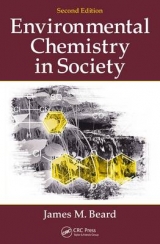
Environmental Chemistry in Society
Crc Press Inc (Verlag)
978-1-4200-8025-4 (ISBN)
- Titel erscheint in neuer Auflage
- Artikel merken
Taking a nonmathematical approach to the material, Environmental Chemistry in Society presents the chemistry of the environment in a way accessible to students who have little or no science background. It relates the fundamentals of chemistry to contemporary environmental issues.
Shows the Relevance of Chemistry in the Environment
Requiring no prior experience within the field, the text first supplies all the background information necessary to grasp the issues explored in later chapters. It reviews the laws of thermodynamics and conservation of matter; basic chemistry concepts, such as chemical bonding, acid–base theory, and oxidation–reduction; carbon, oxygen, hydrogen, nitrogen, phosphorus, and sulfur cycles; and modern environmental toxicology topics, such as organochlorine pesticides, polychlorinated biphenyls, dioxins, and endocrine toxins. The author then focuses on current environmental issues, including energy conservation, smog, indoor air contaminates, global warming, ozone depletion, water shortages and pollution, and solid and hazardous wastes. Presenting ways to combat these problems, he explores hydrogen fuel cells, catalytic converters, the phase out of chlorofluorocarbons, and desalinization.
Catawba College, Salisbury, North Carolina, USA
Background to the Environmental Problem
Preagricultural Development
Horticulture and Agriculture
The Development of Towns and Cities
The Industrial Revolution, Phase I (Approximately 1760–1860)
The Industrial Revolution, Phase II (Approximately 1860–1950)
Science and the Scientific Method
Science and Technology
Science and the Environment
The Environment and Public Policy
The Natural Laws
Matter
The Early Development of Chemistry
Lavoisier and the Law of Conservation of Matter
Disorder
Work and Energy
The First Law of Thermodynamics
The Second Law of Thermodynamics
Matter, Energy, and the Environment
Some Basics of Chemistry
The Atomic Theory
The Periodic Law
The Mole
Symbols, Formula, and Equations
Chemical Bonding
Acids and Bases
Precipitation Reactions
Oxidation–Reduction
Organic Chemistry
Nuclear Chemistry
Element Cycles
Compartments
The Carbon Cycle
The Oxygen Cycle
The Hydrogen Cycle
The Nitrogen Cycle
The Phosphorus Cycle
The Sulfur Cycle
Other Cycles
Toxicology
History of Toxicology
Environmental Toxicology
Toxicity Measurements
Routes of Exposure
Respiratory Toxins
Rates of Chemical Reactions, Catalysis, and Enzymes
General Metabolic Toxins
Neurotoxins
Endocrine Toxins
Allergens
Carcinogens
Mutagens
Teratogens
The Environmental Degradation of Toxins
The Environmental Movement of Toxins
Energy and Modern Society
Energy Sources
Electricity
Widely Used Energy Sources
Nuclear Power
Biomass
Emerging Energy Sources
Hydrogen as Fuel
Energy Conservation
Weather and Climate
The Atmosphere: Composition, Structure, and Dynamics
The Water Cycle
The Weather
Climate
Air Pollution
Classical Air Pollution
Industrial Smog
Photochemical Smog
Regionalization of Air Pollution
Air Pollution and the Law
Pollution Reduction
The Air Inside
Some Background on Indoor Air Quality
Classification of Indoor Air Contaminants
Remedies for Indoor Air Contamination
Global Atmospheric Change
Gases as Insulators: The Greenhouse Effect
Global Warming: The Concept
Is Global Warming Important?
Global Warming: The Effects
International Agreements on Global Warming
Chemistry of the Stratosphere: The Ozone Layer
The Importance of the Ozone Layer
Ozone Depletion and Chlorofluorocarbons
National and International Response to Ozone Depletion
Water
The Physical Properties of Water
Water and Life
Locations of Water
Types of Water Use
Freshwater Shortages
Problems from Overuse of Groundwater
Water Shortage Solutions
Water Pollution
The Nature and Sources of Water Pollution
Types of Water Pollutants
Pollution of Surface Water
Pollution of the Oceans
Pollution of Groundwater
Water Pollution Control
Solid Wastes
Sources of Solid Wastes
Composition of Domestic Solid Waste
Solid Waste Disposition
Hazardous Wastes
What Are Hazardous Wastes?
Where Do Hazardous Wastes Come from?
Historical and Traditional Approaches to Hazardous Waste Disposal
Current Practices in Hazardous Waste Management
Special Considerations for Radioactive Wastes
Index
Discussion Questions and a Bibliography appear at the end of every chapter.
| Erscheint lt. Verlag | 29.9.2008 |
|---|---|
| Zusatzinfo | 121 equations; 18 Tables, black and white; 2 Illustrations, color; 91 Illustrations, black and white |
| Verlagsort | Bosa Roca |
| Sprache | englisch |
| Maße | 156 x 235 mm |
| Gewicht | 522 g |
| Themenwelt | Naturwissenschaften ► Biologie ► Ökologie / Naturschutz |
| Naturwissenschaften ► Chemie | |
| ISBN-10 | 1-4200-8025-3 / 1420080253 |
| ISBN-13 | 978-1-4200-8025-4 / 9781420080254 |
| Zustand | Neuware |
| Informationen gemäß Produktsicherheitsverordnung (GPSR) | |
| Haben Sie eine Frage zum Produkt? |
aus dem Bereich



